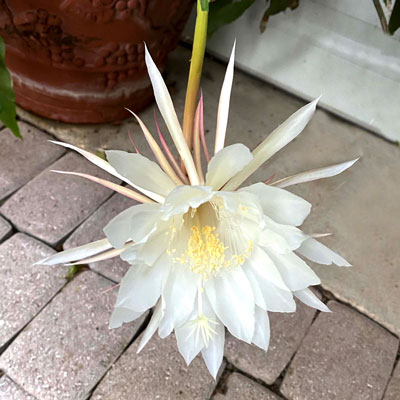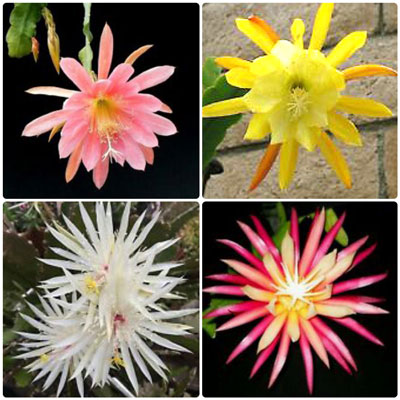Night-Blooming Beauty: October 8, 2020

All cacti have thorns, right? Wrong! Some are smooth as glass.
All cacti grow in the desert, right? Nope! Some grow where it rains 100 inches or more.
All cacti grow in the soil don’t they? Not the epiphytes – those types that grow suspended from trees.
And that’s why we called this meeting.
Let me give you just a bit to get you started.
First of all, in doing a little homework yesterday, I found that the most engrained enthusiasts – those folks who set up the society in California – choose not to call these “night-blooming cereus” like many of us have. That’s why their organization is the Epiphyllum Society of America. (The website seems a few years out-of-date, but everything still works, so I’ve given you the link. There is good background information, and if you click through it, some really nice photographs of the breeders’ varieties.)

Just a few basic facts for beginners…
• These are true members of the Cactus plant family.
• They have no thorns.
• They grow suspended in trees (like many bromeliads and orchids).
• They are native to tropical rainforests.
• The plants can get huge (to 5 or 7 feet across).
• Epiphyllums grow best in dappled sun or moderate shade – no direct sun in the summer.
• They require very porous potting soil (like you would expect to form naturally in the crotches of tree trunks).
• Terra cotta or concrete pots are best to counteract weight of the large plants.
• Also called “orchid cacti” because of their very showy blooms, epiphytic nature and downward-hanging growth.
• Most types are white-flowering, although breeders have introduced scores of red, pink and purple hybrids.
• Blooms last only one night, but are produced in great numbers, usually during summer and fall.
• Most types are fragrant while blooming.
• Some produce showy red fruit following flowering.
• Plants are easily started from cuttings.

Sources…
You may be lucky enough to have a friend or grandma who will share a cutting of an old-fashioned white “Epi” with you. Many local independent retail nurseries offer them in with their other succulent plants, so that’s another reliable source.
And, there are online specialists selling them, often from California. I haven’t bought from any, so I’m hesitant to recommend any specific one.
However, eBay remains a good possibility and it’s still a great time to have plants and cuttings shipped in (before it turns cold). I just did an eBay search for “Epiphyllum” and there are currently 1,092 plants being offered, including some spectacular and colorful hybrids. I fully intend to buy and try 6 or 8 immediately. Remember the story I wrote here a couple of weeks ago giving tips on buying plants from eBay? Those tips might serve you well now.
